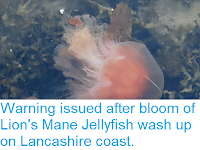Over 2630 people have been stung by Portuguese Man 'o War, Physalia physalis, on beaches in Queensland this weekend (5-6 January 2019), with more than 13 000 people being stung on beaches in the state in the first week of January, more than double the yearly average for the past ten years. A number of people have required hospital treatment due to stings, and coastguards have been forced to close several popular beaches to prevent further incidents.
A Portuguese Man 'o War, Physalia physalis, on a beach in Queensland this week. AAP.
Portuguese Man o' War are colonial Siphonophores only distantly related
to true Jellyfish, Scyphozoa, though commonly referred to as such. Their
bodies are made up of thousands of individual zooids, each with their
own sting, tentacles and digestive system. New zooids are formed by
budding from other members of the colony, but remain attached to these
to form a single colony. Each year a generation of specialist sexual
zooids (gonozoids) is produced which produce eggs and sperm, with
fertilised eggs going on to form new colonies. These animals are
anchored to the sea surface by a highly modified zooid which forms an
air sack, filled with a mixture of carbon monoxide defused from the
zooid and nitrogen, oxygen and argon from the atmosphere, which are
brought into the sack through osmosis. Portuguese Man o' War produce an
extremely strong venom, for both capturing food and defending the
colony, and which is capable of causing extremely painful stings, and
sometimes death, in Humans, for which reason people are advised to be
extremely cautious on beaches where these animals wash up, not just of
entire animals but also detached tentacles, which are less visible but
still capable of stinging.
The swarms of Portuguese Man o' War are adding to the problems being caused by large numbers of Irukandji Jellyfish, Carukia barnesi, a highly venomous species of Box Jellyfish, being washed up on Queensland beaches this summer. Both species are found in the waters to the north of Australia all year round, and
move south during the southern summer, making them a threat to bathers
along the north Australian coast. The Jellyfish move further south in
warmer years, and there are concerns that rising sea temperatures
associated with global warming may lead to them moving further south in
the future.
See also...
Follow Sciency Thoughts on Facebook.







